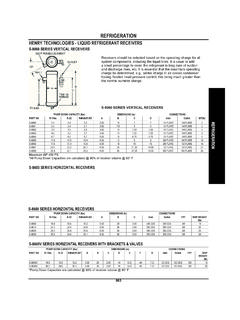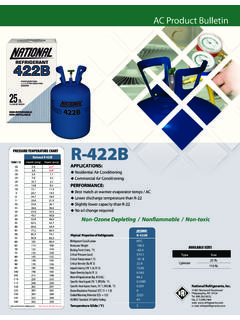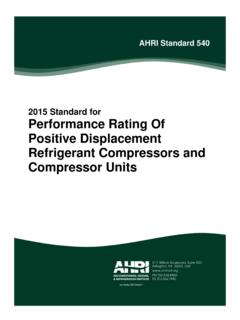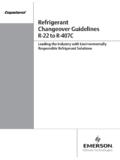Transcription of REFRIGERATION & AIR CONDITIONING GUIDE
1 [Type text] REFRIGERATION & AIR CONDITIONING GUIDE compressor troubleshooting GUIDE : Understanding the Cooling Cycle 4/17/2009 A1 compressor , Inc. Horace Park A1 compressor , Inc compressor trouble shooting GUIDE CONFIDENTIAL QMF - 49 2 REFRIGERATION & AIR CONDITIONING GUIDE A p r i l 1 7 , 2 0 0 9 DYNAMICS OF COMPRESSION compressor troubleshooting GUIDE INDEX 1. Introduction: Function of compressor 2. Super Heat 3. Charging A System 4. Oils 5. REFRIGERATION Controls 6. Accumulators 7. Suction Line Filters 8. What is a BTU? 9. Thermostatic Expansion Valves 10. Relay and Cap Assemblies 11. Pump Down Systems 12. compressor Failures 13. Installing a New compressor 14. How to Install a New compressor 15. Brazing & Welding 16. Glossary 17. REFRIGERATION Cycle 18. Frequently Asked Questions 19. Tecumseh Pressure Control Settings 20. 06E Semi-Hermetic compressor Diagram (Press CTL + click to follow the hyperlink ) A1 compressor , Inc compressor trouble shooting GUIDE CONFIDENTIAL QMF - 49 3 REFRIGERATION & AIR CONDITIONING GUIDE A p r i l 1 7 , 2 0 0 9 1.
2 FUNCTION OF A compressor The function of a compressor is the same for either REFRIGERATION or A/C. It is really very simple. You are essentially transferring heat from one place to another; cooler, freezer or room. You are never adding are removing heat. Transferred by low pressure (low temp) Refrigerant in the evaporator and moving it to the condenser where it is High Pressure High Temperature. Usually, the fan moves the lower temp air across the super heated refrigerant high condenser coil cooling it. This is where you feel the heated air. This is the heat removed from the room, cooler or freezer along with the heat of compression from the compressor . This brings me to the next part of compressor function: refrigerant flow. Starting at the discharge line at the compressor you will notice that this is the smallest line and should be the hottest one of the two that is connected to the compressor .
3 The Discharge Line takes the hot refrigerant from the compressor to the condenser where it is cooled changing it from a hot refrigerant to a sub cooled liquid. As the liquid leaves the condenser it will usually go to a receiver tank then to the liquid line sometimes straight to the liquid line depending on the expansion device. The next stage in the process is the Drier. The Drier removes the moisture and debris, if any, from the refrigerant. All Driers have an arrow on them. The arrow should always be pointed toward the evaporator and away from the condensing unit. The Expansion Device follows. There are usually only 3 types: 1. Capillary type; 2. Expansion Type; & 3. Orifice Type. Regardless of the type, they all do the same thing---Drop the Pressure which lowers the temperature of the liquid refrigerant below the temperature of the room or box. The cold liquid now enters the evaporator unit, which is located inside the room or box, travelling through the coil where a fan usually blows warmer air across the cold refrigerant boiling it like water on a stove.
4 The cold liquid picks up the heat of the box and at the end of the coil is only a super heated vapor. The super heated vapor travels to the low side of the compressor . This line is the coolest and largest one that is connected to the compressor . Now the compressor sucks the low pressure refrigerant vapor pushing it to a high pressure high temp Vapor where it started its cycle all over again dissipating the heat it has removed from the evaporator. Back to the Index A1 compressor , Inc compressor trouble shooting GUIDE CONFIDENTIAL QMF - 49 4 REFRIGERATION & AIR CONDITIONING GUIDE A p r i l 1 7 , 2 0 0 9 2. SUPER HEAT SUPER HEAT EXPLAINED Say Super Heat to a mechanic and they will act like they know what it is but often they really don t understand. Here I will explain what Super Heat is, how to find it and how to set it in simple English. Simply, Super Heat is the temperature of the Suction Line at any given point and the suction pressure converted to temperature (see temp / pressure chart or even the conversion temp inside your gauges R-22, etc.)
5 The difference is Super Heat. The Suction Line temp will be the same or higher ..It can never be colder than the Chart temp. This chart temp is also the Evaporator Temp. Subtract the conversion chart temperature from the Suction Line Temperature and the difference is SUPER HEAT. So, let s measure the suction of an A/C unit using R-22. For example purposes, let s say it measures 58 deg. F and we have a 65# suction pressure. Look either at the Green R-22 temp inside the suction gauge or look at your Refrigerant Temp Pressure Chart and you will see that 65# suction is 38 deg F. The difference between the 58 deg F we measured to the 38 deg F chart temp is Super Heat or, in this example, 20 deg F of Super Heat. So, what does this mean? Twenty (20) degF of Super Heat at the compressor is ideal. It means that somewhere up the suction line the Liquid Refrigerant has changed to all vapor. All REFRIGERATION and A/C Compressors are designed to pump vapor not liquid.
6 If the Super Heat is too low, 10 deg F or less, and you will run the risk of damaging the compressor . Low Super Heat will either thin the oil so it doesn t do its job or it enters the cylinder and can t get out fast enough. Either way, rods break and you are changing out a compressor . If the Super Heat is too high the compressor will run hot. SETTING SUPER HEAT Rule number 1, SUPER HEAT CHANGES, so to set it properly the Room or Box needs to be at the desired temperature. Setting this is to regulate the amount of liquid left at the end of the Evaporator. This is done by adjusting the Expansion Valve by screwing the adjustment screw--- Screwing In raises the Super Heat and Out lowers it. If this is an orifice or capillary tube, first check the box or unit for the weight of refrigerant, the amount of refrigerant and the discharge pressure will set the Super Heat. Less refrigerant will usually raise the Super Heat.
7 Raising and lowering super heat cools the compressor and its oil and head temperature. Ideal is 20 deg at the compressor . Sometimes a short suction line makes this hard to do. In this instance, get what you can. The key point is that you must have Super Heat or a compressor will be the next thing you change!!!! Back to the Index A1 compressor , Inc compressor trouble shooting GUIDE CONFIDENTIAL QMF - 49 5 REFRIGERATION & AIR CONDITIONING GUIDE A p r i l 1 7 , 2 0 0 9 3. CHARGING A SYSTEM Charging a system can be somewhat tricky when you take into consideration capillary tubes, head master valves and fan cycle controls and suction pressure regulators. EVACUATING A CHARGED SYSTEM It is necessary before charging any system to remove air and any non-condensable that is ion the system. If they are not removed, they will become trapped at the top of the condenser taking up space and robbing the system of its ability to remove heat.
8 The length of time it takes to evacuate a system is only as long as it takes to reach as 25 28 of vacuum. Then break the system by adding a small amount of refrigerant to the longest end of the system and allowing it to reach 25 28 of vacuum again. Now you are ready to charge the system in the discharge line before turning the system on. The only reason to evacuate a system for a long period of time, such as overnight, is if you feel that the system has water in it. If it does, you better have a real good pump to get the water to boil off in a vacuum otherwise this process can be done usually in 30 minutes or less. CHARGING AN EMPTY SYSTEM Step one is to evacuate the system to remove all non-condensable form the system and clean the condenser. This will allow you to get a good idea of when you have enough refrigerant in the system if you don t know the factory charge. The condenser is designed to remove a certain amount of heat (BTU s) from the Box or Room usually at 90 deg F of ambient.
9 So if your condenser is clean and you charge the system until the liquid line or drier gets good and warm you are now removing all the heat from the box or room that it is designed to remove your charge should be very close to being correct. Never let the liquid line get Hot!!!! Check your Super Heat after the Box or Room comes down to the desired temperature. ADDING REFRIGERANT Adding refrigerant to a system that has a partial charge has usually three rules of Thumb: 1. Clear the sight glass 2. A Warm the liquid line 3. And, most important, is suction pressure. With the 100+ refrigerants on the market, always consult your Pressure Chart for the correct suction pressure. If your suction pressure gets too high, you can flood the evaporator with liquid. The correct charge is to have 6 10 deg Super Heat at the end of the Evaporator. Remember, the refrigerant needs to be at least 10 deg F colder than the box or the room in order to remove the heat.
10 A1 compressor , Inc compressor trouble shooting GUIDE CONFIDENTIAL QMF - 49 6 REFRIGERATION & AIR CONDITIONING GUIDE A p r i l 1 7 , 2 0 0 9 We have not discussed Discharging Pressures. This is because there are so many refrigerants that discharge pressure could be as little as 100lbs and as much as 350lbs. Discharge temperature is what is important. CHARGING A SYSTEM WITH A SUCTION LINE REGULATOR This is a somewhat slow and usually wait and see process because, until the box reaches temperature a true suction pressure is unknown. Smaller systems with capillary tubes should be weighed in and the OEM charge needs to be known first. Larger systems with receivers & TEV valves are tough. If the system is empty, look at the receiver to get a good feeling for an amount. If the box is short of refrigerant slowly clear the sight glass. Either way, you must check the Super Heat after the box has reached its temperature.





